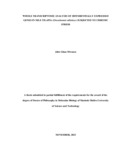| dc.description.abstract | Chronic stress is the long-term activation of the stress response system and is a major bottleneck to aquaculture production as it lowers productivity and compromises fish welfare. Several studies have attempted to infer the presence of stress, however, there is paucity of information regarding quantification and the mechanisms by which chronic stress depresses growth. A few studies have attempted to determine which genes are regulated in chronic stress and how chronic stress impacts metabolic pathways. Furthermore, in cultivated Nile tilapia (Oreochromis niloticus L.), only a small number of genes conferring advantageous phenotypes have been identified. The current study investigated the relationship between stress levels and growth performance in relation to the metabolic pathways regulated in response to chronic stress in cultured Nile tilapia. Juvenile Nile tilapia were cultured in the laboratory at different ammonia concentrations and stocking densities for 70 days. Growth performance was determined alongside renowned stress markers: glucose and cortisol levels, followed by RNA sequencing and differential gene expression. Fish in the treatment groups showed negative allometry while the controls showed positive allometric growth. The specific condition factor (Kn) ranged from 1.17 for the controls to 0.93 for the ammonia treatment and 0.91 for the stocking density treatment. Results of this study indicated a positive correlation between the levels of stressors and the indicators of stress i.e. concentrations of blood glucose, plasma cortisol and scale cortisol. There was a significant difference (p<0.05) in the mean plasma cortisol levels between ammonia treatments and the control (p< 0.05 i. e 4.71 ± 0.52 ng/ml and 6.50 ± 0.83 ng/ml) respectively. The cortisol levels increased concomitantly with the concentration of ammonia. There was also a significant difference in the plasma cortisol levels between the low fish stocking densities and the high fish stocking densities. Comparative transcriptome analysis revealed 209 Differentially Expressed Genes (DEGs) (156 up- and 53 down-regulated) in ammonia and 252 DEGs (175 up- and 77 down-regulated) in stocking density treatment. In both treatments, 24 and 17 common DEGs were up- and down-regulated respectively. DEGs were significantly enriched in six pathways associated with muscle activity, energy mobilization and immunity. The heightened muscular activity consumes energy which would otherwise have been utilized for growth. Comparative genomics identified similarities between fishes with common genetic and evolutionary ancestry, allowing for better adaptation to local environmental conditions. Some of the selected genes exhibiting substantial effect on immunity include: Prxs, MMR1 like, ZMYM4-like partial; Stress reactive genes including: PALLD-like gene, LPLBAG6-like and growth-related genes including: NF1x like, PEDF and CL like. Experimental sample, O. niloticus, O. aureas and Danio rerio can hybridize in their natural environments bringing about genetic admixture ancestry that hybridises new genes which confer beneficial phenotypes. These results bring to fore the molecular mechanisms underlying chronic stress’ suppression of growth in cultured Nile tilapia and can inform formulation of breeding programmes targeting stress resistance. The results of this study lays the foundation for the development of fish breeds that are climate-ready and able to weather climate shocks. This will allow Aquaculture to contribute to food and nutrition security in line with SDG2 and improve the economic status of fish farming communities in the Global South. | en_US |

